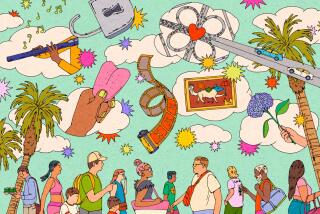‘Open’ by Andre Agassi
The photograph of Andre Agassi on the cover of “Open,” his just-published autobiography, was taken by Martin Schoeller, an Annie Leibovitz disciple. The book begins with a quote from Vincent van Gogh; Barbra Streisand is thanked in the acknowledgments. The ghostwriter is J.R. Moehringer, a Pulitzer Prize-winning reporter who formerly worked for The Times.
In other words, “Open” is not your typical jock-autobio fare. This literate and absorbing book is, as the title baldly states, Agassi’s confessional, a wrenching chronicle of his lifelong search for identity and serenity, on and off the court.
The journey began not long after Agassi’s truncated childhood. His father, Mike, a former boxer from Iran who settled in Las Vegas, was an overbearing sports parent. (Think Marv Marinovich.) An obsessed drillmaster, Mike tried to mold his kids into stars. Only the youngest made it big, although he had little choice in the matter.
“No one ever asked me if I wanted to play tennis,” Andre Agassi writes, because “what I want isn’t relevant.” A prodigy who traded volleys with Björn Borg at age 8, he came to dread the ball machine, nicknamed “the dragon,” that his father concocted for endless hitting sessions.
In seventh grade, Agassi was shunted off to Florida to be tutored by controversial coach Nick Bollettieri. He’d dropped out of high school by age 14. The absurd scenes here describing Bollettieri’s academy, which Agassi calls a “glorified prison camp,” read like something from David Foster Wallace’s novel “Infinite Jest.”
When Agassi turned pro, he had plenty of game and a teenager’s inarticulate bravado. He donned denim shorts, wore an earring, and added frosted highlights to his mullet. (It was the 1980s.) The media interpreted this as the “real” Andre, the rebel without much cause. One of his endorsements, which carried the unfortunate tag line “Image Is Everything,” came to represent what many believed was his essential flaw.
By turns angry, fragile and apathetic, Agassi routinely lost important matches and seemed unable to handle pressure. Worse, he offered excuses for every defeat.
At the 1990 French Open, site of his first Grand Slam final, he wore a hairpiece to conceal his thinning hair. Concerned that the wig would fly off, he played tentatively and lost to an inferior opponent.
“Open” is rife with self-damning revelations. Agassi acknowledges using crystal meth throughout 1997 and then lying about a positive drug test to avoid punishment by tennis authorities. He confesses that he tanked certain matches.
After taking the court and winning without any underwear, he goes commando for the remainder of his career.
Agassi repeatedly notes that he “hates” tennis. It’s telling that, for years, no one believed him -- after all, slamming a fuzzy ball was making him millions -- but the solitary existence on the circuit haunted him. “In tennis you’re on an island,” he writes. It is “the loneliest sport.”
He credits a cobbled-together support system with saving him from a Jennifer Capriati-like flameout; at various times, the crew included coaches (for years, former top-ranked player Brad Gilbert), trainers (Gil Reyes) and friends (Streisand). According to Agassi, they enabled him to face his demons and, finally, to perform to his immense potential. Before retiring in 2006, he captured all four Grand Slam titles, and eight total Slams.
Agassi never managed to eclipse Pete Sampras, his Palos Verdes-raised rival and winner of 14 Slams. Agassi respected the grinding brilliance of Sampras, but abhorred his single-minded pursuit of tennis immortality. “I envy Pete,” he writes. “I wish I could emulate his spectacular lack of inspiration, and his peculiar lack of need for inspiration.”
“Open” offers plenty of inside-the-locker-room intrigue, and its candor extends to Agassi’s personal life. Of his marriage to actress Brooke Shields, he writes, “I have a thought no man should have on his wedding day: I wish I were leaving too. I wish I had a decoy groom to take my place.”
Eventually, Agassi connected with his soul mate: tennis hall-of-famer Steffi Graf. They shared similar upbringings: Graf’s father was as maniacal as Agassi’s dad. The description of the fathers’ initial meeting -- the two men nearly come to blows arguing about forehands and backhands -- would be amusing if it weren’t so pitiable.
Agassi has publicly praised the contributions of the latest member of his team: Moehringer (who is uncredited in the book by his own choice). They met and agreed to work together after Agassi was entranced by Moehringer’s acclaimed memoir, “The Tender Bar.”
This was a wise choice, indicative of Agassi’s hard-won maturity. Moehringer is a masterful storyteller, and both “The Tender Bar” and “Open” explore similar themes: the horrifying toll of parental neglect; the roller-coaster quest for self-identity; the all-too-human need to connect with others; the messy ways we cope with life’s inevitable setbacks; the possibility of metamorphosis and redemption.
The latter resonates throughout “Open.” As Agassi better understands his love-hate relationship with tennis and grudgingly embraces his stature, he undergoes a profound shift. The self-centeredness of “What do I have to do to be No. 1?” gives way to “What can I do to help others?”
The answer for Agassi, the high-school dropout, has been to finance and build a public charter school that serves low-income youth in Las Vegas. Like “Open” itself, it’s an inspiring achievement.
Davis is a contributing writer at Los Angeles magazine.
More to Read
The biggest entertainment stories
Get our big stories about Hollywood, film, television, music, arts, culture and more right in your inbox as soon as they publish.
You may occasionally receive promotional content from the Los Angeles Times.










